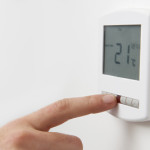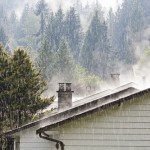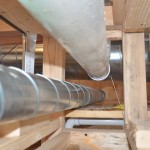
From the original wood-burning fireplace to the most modern geothermal radiant system, home heating has come a long way over the centuries. Here we look at different options for central heating: systems where heat is distributed from a main location throughout a house.
Forced air heating is the most common type in North America. It consists of a central furnace connected to the rest of the house with ductwork that distributes heated air to each room. The furnace provides heat by burning oil, propane or natural gas and uses a heat exchanger to prevent gases entering the heated air. The furnace needs to be vented to the outside and receive fresh air from exterior vents.
A blower fan forces the air through the ductwork and return plenums connected to large grilles that also return cool air for reheating. As the system is blowing air around it can also spread allergens and dust so a filter is necessary on the return air circuit.
One main advantage to forced air is that it’s relatively easy to add air conditioning to the system and have it use the same ductwork. But, compared to other systems it can be noisy and heat a home unevenly.
Heat pumps are similar to air conditioners and use refrigerant; yet they can be used for heating as well as cooling. When used for heating it works like a refrigerator in reverse drawing heat from a cooler space and releasing it into a warmer one. When used for cooling, the circuit is reversed. They are most often used in mild climates where, because they move heat instead of generate it, they offer an energy efficient alternative to furnaces and air conditioners. However, as they are not very efficient in freezing temperatures they are usually paired with a furnace, with which they share the ductwork.
Hydronics refers to heating with water. In the past, hot water or steam radiators were the most common method of heating a home. Well, now they’re making a comeback. The water is heated by a central boiler that burns oil, propane or gas or runs on electricity. The boiler circulates heated water or steam through radiators or radiant heating tubing in floors or ceilings.
Although the name radiator implies they radiate heat they instead use convection, which is when heated air rises up and cooler air descends. Hydronic systems have the advantage that they don’t blow dust and allergens around and provide continuous warmth.
Radiant heating refers to heating a floor, wall or ceiling using hot water in buried heating tubes or electric elements. It has the advantage of providing comfortable and even heat without needing high temperatures; that’s because the heated area is much larger than in other systems.
It has the disadvantage that it is a relatively slow cycle of heating so needs to be left on almost continually. Now there are options to install radiant heat using a geothermal heat source. The loops of water beneath the flooring are connected to loops in the ground below the house taking in heat from the earth’s geothermal energy. This method can also be used in conjunction with geothermal heat pumps.
There are pros and cons to each system but which is the most eco-friendly? With improvements in efficiency of furnaces and boilers, the forced air and hydronics options combined with heat pumps still remain in the running with the more exotic geothermal ones.



